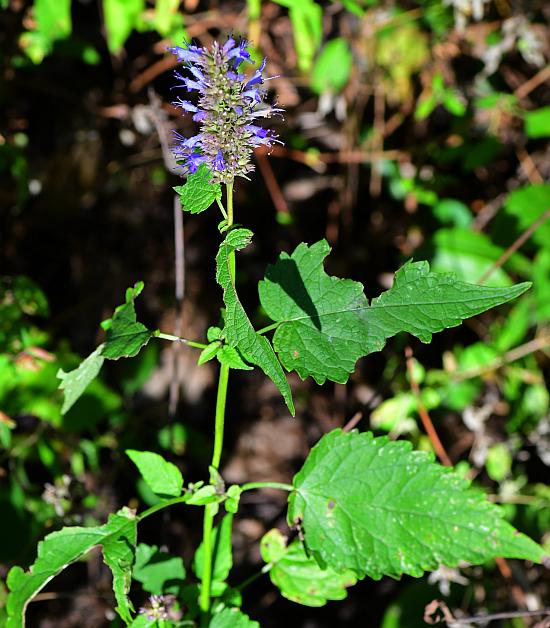Agastache scrophulariifolia (Willd.) Kuntze
Purple Giant Hyssop

Native
CC = 9
CW = 5
MOC = 6
SRank = S1
© SRTurner
Agastache scrophulariifolia (Willd.) KuntzePurple Giant Hyssop | |
 |
Native CC = 9 CW = 5 MOC = 6 SRank = S1 |
© SRTurner |
|
Family - Lamiaceae Habit - Perennial forb with fibrous roots and sometimes short rhizomes. Stem - Ascending to erect, to 1.5 m, stout, sharply 4-angled, moderately to densely pubescent with more or less spreading, multicellular hairs.
Leaves - Opposite, petiolate. Petioles 0.8-6.0 cm long. Leaf blades 2-15 cm long, the upper surface moderately pubescent with short, relatively stiff hairs along and between the veins, the undersurface moderately to densely pubescent with finer, somewhat crinkled, more or less spreading hairs, and also with inconspicuous, sessile glands.
Inflorescence - Dense, terminal, cylindrical spikes 3-17 cm long, 1.5-2.5 cm in diameter, the bracts elliptic-ovate to nearly circular, shorter than to more commonly slightly longer than the calyces.
Flowers - Calyces 4.0-6.5 mm long, green with the lobes often pale pinkish-tinged, the lobes 2.0-2.5 long at flowering (to 3.2 mm at fruiting), ovate, angled to bluntly to sharply pointed tips. Corollas zygomorphic, 5-8 mm long, light pinkish purple to pale bluish purple or less commonly white. Stamens 4, strongly exserted, the lower 2 stamens with slightly shorter filaments that are slightly curved under the upper corolla lip, the upper 2 stamens with slightly longer, straight filaments (angled slightly downward), the anthers small. Ovary deeply lobed, the style appearing nearly basal from a deep apical notch. Style exserted, more or less equally 2-branched at the tip.
Fruits - Dry schizocarps, separating into usually 4 nutlets, these 1.2-1.5 mm long, oblong-obovoid to oblong-ellipsoid, the surface yellowish brown, densely and minutely hairy at the tip, otherwise glabrous and slightly roughened. Flowering - July - September. Habitat - Bottomland forests and forest openings, streambanks, swales in mesic upland prairies, roadsides. Sometimes cultivated. Origin - Native to the U.S. Lookalikes - None. Other info. - This beautiful species is rare in Missouri, with only three specimens being collected from the wild within the past century. It may well be waning in Missouri. It is more common in the upper Midwest and ranges into New England and Canada. The plant is recognized by its opposite, petiolate leaves and cylindrical inflorescences of bluish flowers. As is the case with the far more common A. nepetoides, the flowers do not all open at once, but rather at seemingly random spots within the spike over a period of time. Photographs taken at Prairie Fork Conservation Area, Callaway County, MO, 10-18-2021 (SRTurner). |